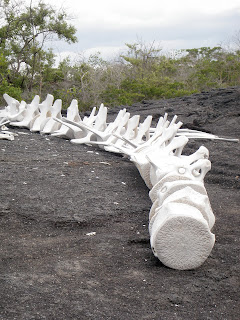R: We made our last landing on Isabela Island this morning on a beach in Urvina Bay. We saw some swimming flightless cormorants and penguins from a distance, and several hermit crabs greeted us on the beach.
J: Juan told us a story about the feral goats that had previously inhabited Isabela Island. Because the goats were an introduced species, the park service wanted to rid the islands of them. To accomplish this goal, they released a “Judas Goat” (particularly cruel to the male goats as it was a female in heat) into the wild to track down the various herds of goats. Once they were located, the rangers would eliminate them and relocate the Judas Goat so that it could track down another herd. The mission was successful as Isabela Island is now free of feral goats.

Scary tree-goat.
R: We saw a few remaining goat skulls as well as telltale patches of ground with absolutely zero vegetation to show that the goats were once there. This area of the island was also different because an earthquake in the ‘50s elevated the beach, so we saw an inland beach complete with some sand dollar pieces further inland along our walk. We also saw some more land iguanas, but as this island is less visited and more remote, they were much more skittish than those we first saw on South Plazas. Boy can skittish land iguanas move fast.
Next, more snorkeling! Though today’s left a little to be desired as the water was pretty murky. The highlight was before we even got in the water, we saw a California tiger eel swim by the panga, and on the way back to the boat, we saw swimming, mating sea turtles.

This is the eel, not the mating turtles.
J: After lunch, we headed of to Fernandina Island to see the promised orgy of iguanas. And, it was true. There were more marine iguanas than we could count. We even had to watch where we were walking to avoid accidentally stepping on one. I went a little nuts with the photos. I’m not sure I really needed 30 iguana pictures, but that’s the beauty of digital. We also got to see a mink whale skeleton, some living flightless cormorants (those would be birds with tiny useless wings), sally lightfoot crabs and the ever present sea lions. Back on the boat, we began another long sail (11 hours again). Once more, we were promised whales and dolphins. But this time we weren’t disappointed as we got to see some spinner dolphins playing a few hundred yards in front of our boat. Another exciting event of the evening is that we crossed the equator! We’re back the northern hemisphere - at least for a few hours - we cross it again some time in the middle of the night.




